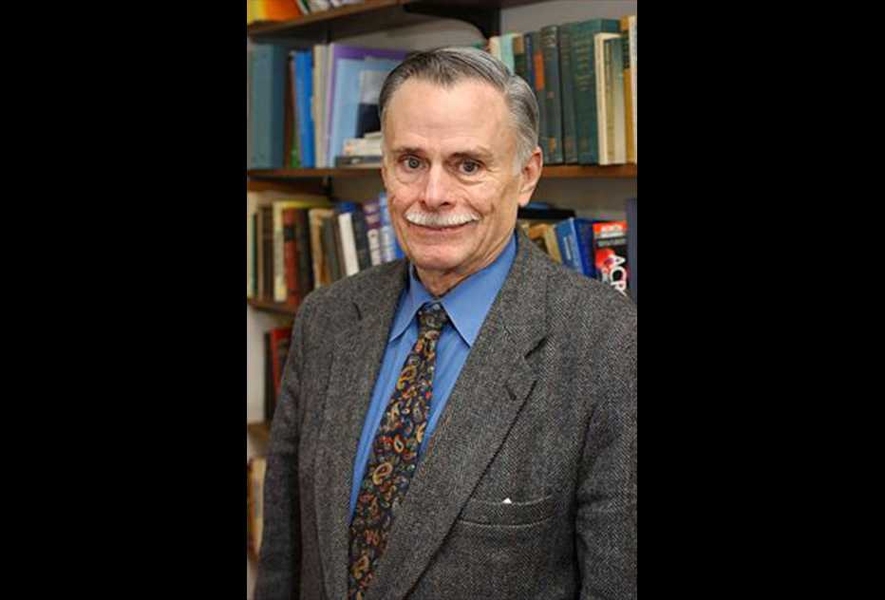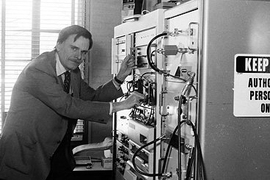John S. Waugh, an MIT Institute Professor emeritus and professor emeritus in the Department of Chemistry, died Friday, Aug. 22, at the age of 85. Waugh was an authority in chemical physics, known internationally for his work in magnetic resonance.
Waugh’s pioneering work in nuclear magnetic resonance (NMR) made it possible to study the molecular structures of proteins involved in Alzheimer’s and Parkinson’s diseases, diabetes, and many other disorders. NMR uses the magnetic properties of atomic nuclei to unravel the structures and dynamics of substances containing those nuclei. In NMR, the magnetic moments of atomic nuclei are stimulated with static and radiofrequency magnetic fields, and give rise to signals useful in a variety of applications — from medical imaging to spectroscopy.
“He was an extremely humble giant in the development of solid-state nuclear magnetic resonance spectroscopy,” says Sylvia Ceyer, head of MIT’s Department of Chemistry. “His keen wit, razor-sharp intellect, and extraordinary sense of humor made him a treasured jewel amongst his colleagues.”
Born in Willimantic, Conn., in 1929, Waugh received his bachelor’s degree from Dartmouth College in 1949, graduating summa cum laude with highest distinction in chemistry. He received his PhD in chemistry and physics from Caltech in 1953. He came to MIT as an instructor in chemistry that same year, and became assistant professor in 1955, associate professor in 1958, professor in 1962, and the Arthur Amos Noyes Professor of Chemistry in 1973.
As a grad student in the lab of Caltech chemistry professor Don Yost, Waugh built his first NMR system with a borrowed magnet and some World War II surplus electronics. When he arrived at MIT, NMR was already a valuable tool for the study of molecular structure — but only for liquid samples.
In the 1960s Waugh developed a way to use NMR to study solids by applying a special sequence of sharp, intense pulses of radiofrequency power. This made NMR useful for analyzing things that don’t dissolve in water, including proteins, nucleic acids (such as DNA), and some drugs. That technique eventually played a role in many of the past half-century’s discoveries in chemistry, physics, biology, and materials science; it is now one of science’s most widely used tools.
"He basically invented the field of solid-state NMR when everyone else had left the field because they thought it was never going to work," says Robert Griffin, an MIT professor of chemistry who was a postdoc in Waugh's lab in the 1970s. "He made some incredible innovations that have led to many important scientific steps forward, and today solid-state NMR is a vibrant enterprise. There's a huge number of people working in it, and it's all because of things that happened in John Waugh's lab."
In 2011, Waugh told MIT News that he never anticipated the wide impact his work has turned out to have.
“I think that’s the way most [scientists] are,” he said. “You start off doing some limited kind of stuff that makes use of any particular talents or knowledge you happen to have. You don’t think of it as being something that’s going to revolutionize the world. It’s just something interesting to do, and might be fun.”
In 1988, Waugh was the recipient of MIT’s James R. Killian Jr. Faculty Achievement Award — an honor bestowed by faculty colleagues in recognition of extraordinary professional accomplishments and service to the Institute. In 2011, he received the Welch Award, given for basic research that benefits humankind.
“Dr. Waugh discovered how to use NMR to study solids, creating a collection of tools that allows researchers to view the structures and properties of proteins, membranes, viruses and many other critical components of life,” said Ernest H. Cockrell, chair of the Welch Foundation, in presenting Waugh the award. “Ultimately, new applications in fields as diverse as medicine and batteries can trace their way back to the research techniques he initiated.”
Waugh also won the Wolf Prize in Chemistry in 1983. He was a member of the National Academy of Sciences, a fellow of the American Academy of Arts and Sciences, and a former chairman of the Division of Chemical Physics of the American Physical Society. He received Dartmouth’s Haseltine Chemistry Prize in 1949, the Humboldt-Preis in 1972, the Irving Langmuir Chemical Physics Award in 1976, the Pittsburgh Spectroscopy Award in 1978, and Caltech’s Distinguished Alumnus Award in 1987. In 1989 he received an honorary doctorate from Dartmouth.
Waugh is survived by his wife, Susan, of Lincoln, Mass.; a daughter, Alice, of Lincoln, Mass.; a son, Frederick, of Austin, Texas; and five grandchildren, Sarah and Rebecca of Lincoln, Mass., and Jack, Ted, and Sam of Austin, Texas.
The News Office will update this story as more information becomes available.








